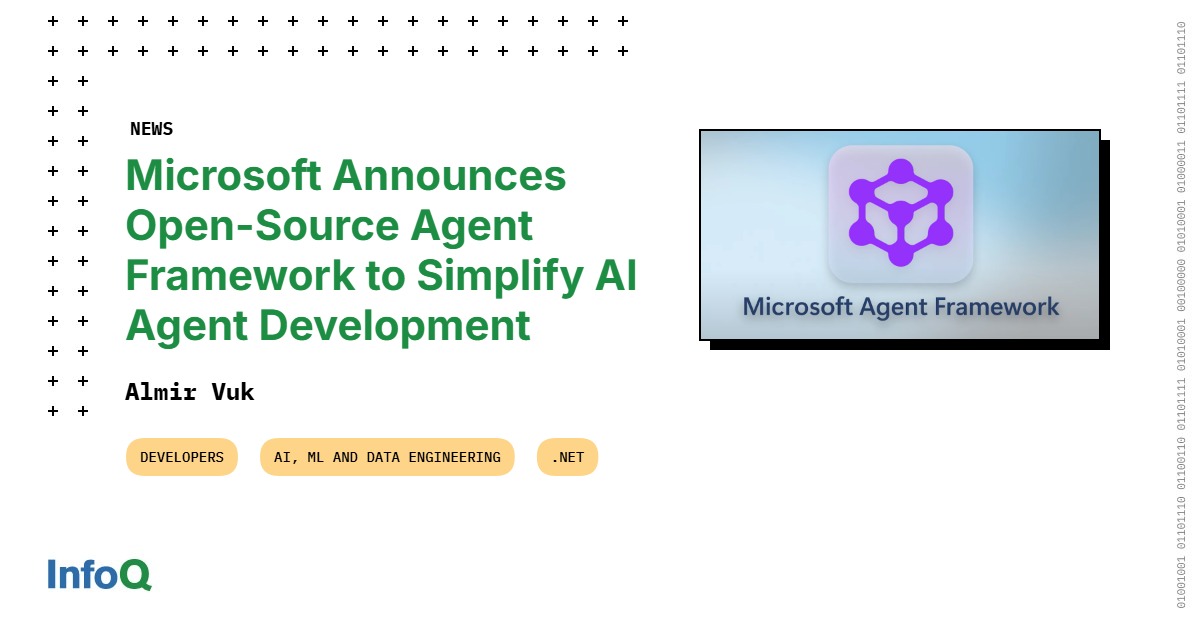Microsoft has announced the preview release of Microsoft Agent Framework, an open-source software development kit designed to simplify the creation and deployment of artificial intelligence agents for developers across all skill levels, as reported in official blog posts from the company’s development teams.
The framework represents a significant consolidation effort, as stated by Microsoft engineers, unifying capabilities from two previously separate projects: Semantic Kernel, which provided enterprise-ready foundations, and AutoGen, developed by Microsoft Research for experimental multi-agent orchestration. According to the announcement, developers previously had to choose between innovation and production stability, a limitation the new framework aims to eliminate.
As noted in the technical documentation, Microsoft Agent Framework enables developers to build AI agents with minimal code requirements. The company demonstrated this simplicity with examples showing functional agents created in fewer than twenty lines of code. “Building AI agents shouldn’t be rocket science,” as stated in the .NET blog announcement, emphasizing the framework’s focus on accessibility for developers without specialized AI expertise.
The framework introduces four core pillars as outlined by Microsoft.
- Open Standards & Interoperability – Enables Model Context Protocol (MCP) support, Agent-to-Agent (A2A) communication, and OpenAPI-based integration, ensuring portability across different runtime environments.
- Pipeline for Research – Advanced orchestration patterns from AutoGen, such as group chat, debate, and reflection capabilities, now delivered with enterprise-grade reliability.
- Extensible by Design – Modular framework featuring connectors to Azure AI Foundry, Microsoft Graph, SharePoint, Elastic, Redis, and additional services. Declarative agent configurations via YAML and JSON enable version-controlled workflow management.
- Ready for Production – Built-in observability through OpenTelemetry, integration with Azure Monitor, Entra ID security authentication, and CI/CD compatibility using GitHub Actions and Azure DevOps.
Early enterprise adoption appears robust, as stated by Microsoft, in the original announcement blog post Microsoft, explains and provide detailed use cases by their customers. So interested readers can explore that section.
As announced, the framework supports multiple orchestration patterns including sequential, concurrent, group chat, and handoff workflows. These patterns, originally developed as research prototypes in AutoGen, now operate with production-grade durability and enterprise controls, as stated by Microsoft engineers.
The technical implementation provides support for both Python and .NET environments, as noted in the GitHub repository documentation. Developers can install the Python version through pip package manager or integrate .NET support through NuGet packages. The framework includes built-in connectors for various enterprise systems, pluggable memory modules supporting multiple backend stores, and declarative agent definitions through YAML or JSON configurations.
To get started developers can use following commands:
pip install agent-framework
dotnet add package Microsoft.Agents.AI
Microsoft has positioned the framework as part of its broader Azure AI ecosystem, as reported in the Foundry blog. The integration includes native support for Azure AI Foundry services, OpenTelemetry instrumentation for monitoring, and compatibility with existing Microsoft development tools including Visual Studio Code through the AI Toolkit extension.
 (Usage of Visual Studio Code Extension, Source: Microsoft Official Blog)
(Usage of Visual Studio Code Extension, Source: Microsoft Official Blog)
For developers currently using Semantic Kernel or AutoGen, Microsoft has provided migration guides, as stated in the documentation. The company emphasized following:
This continuity means developers can preserve their existing investments while unlocking new capabilities. Microsoft Agent Framework is not a replacement for what came before — it is the natural evolution that unites innovation and stability
The framework is available immediately in preview form through Microsoft’s GitHub repository and package managers for both Python and .NET ecosystems. Interested readers can also watch the 30 minute introduction video made by Microsoft team.









